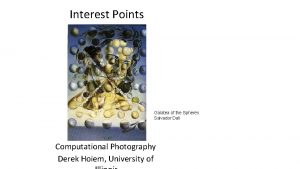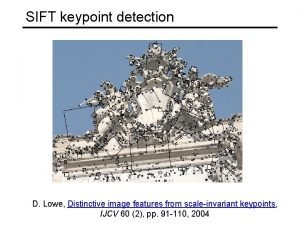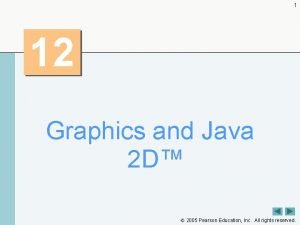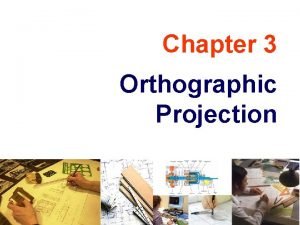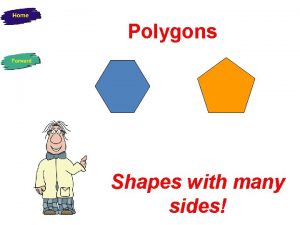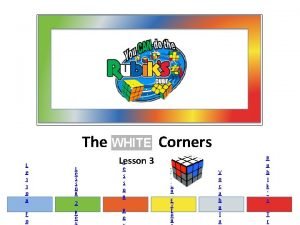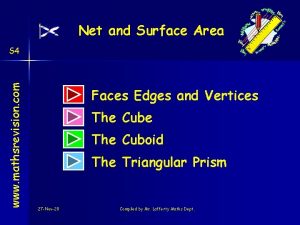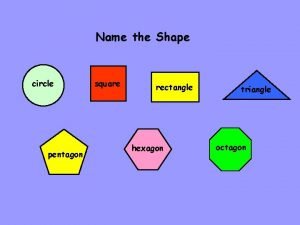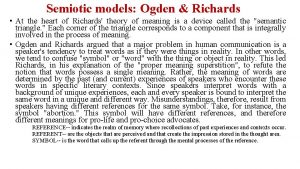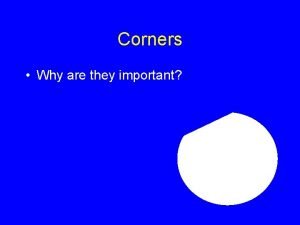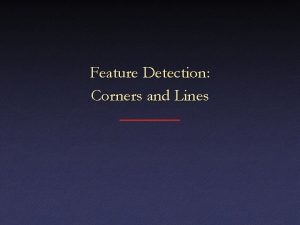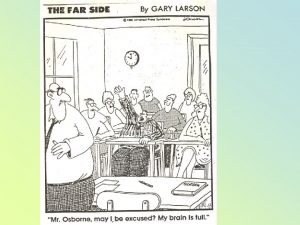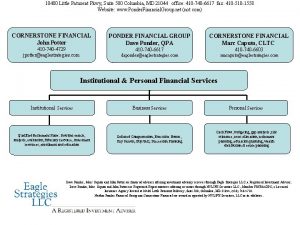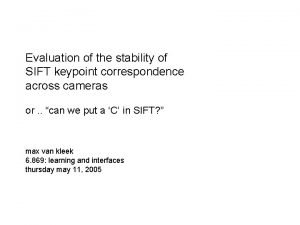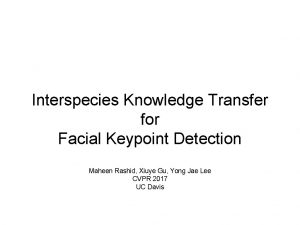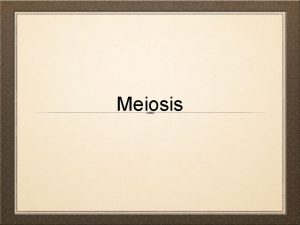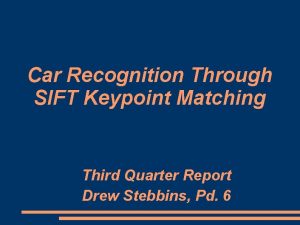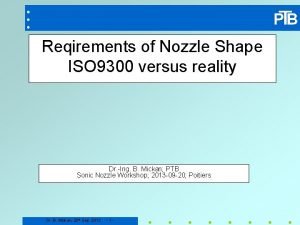Keypoint extraction Corners 9300 Harris Corners Pkwy Charlotte








![Corner Detection: Derivation Change in appearance of window W for the shift [u, v]: Corner Detection: Derivation Change in appearance of window W for the shift [u, v]:](https://slidetodoc.com/presentation_image/aafa4d5914723e12b539a9b77865c4fd/image-9.jpg)
![Corner Detection: Derivation Change in appearance of window W for the shift [u, v]: Corner Detection: Derivation Change in appearance of window W for the shift [u, v]:](https://slidetodoc.com/presentation_image/aafa4d5914723e12b539a9b77865c4fd/image-10.jpg)
![Corner Detection: Derivation Change in appearance of window W for the shift [u, v]: Corner Detection: Derivation Change in appearance of window W for the shift [u, v]:](https://slidetodoc.com/presentation_image/aafa4d5914723e12b539a9b77865c4fd/image-11.jpg)
![Corner Detection: Derivation First-order Taylor approximation for small motions [u, v]: Let’s plug this Corner Detection: Derivation First-order Taylor approximation for small motions [u, v]: Let’s plug this](https://slidetodoc.com/presentation_image/aafa4d5914723e12b539a9b77865c4fd/image-12.jpg)























- Slides: 35

Keypoint extraction: Corners 9300 Harris Corners Pkwy, Charlotte, NC

Why extract keypoints? • Motivation: panorama stitching • We have two images – how do we combine them?

Why extract keypoints? • Motivation: panorama stitching • We have two images – how do we combine them? Step 1: extract keypoints Step 2: match keypoint features

Why extract keypoints? • Motivation: panorama stitching • We have two images – how do we combine them? Step 1: extract keypoints Step 2: match keypoint features Step 3: align images

Characteristics of good keypoints • Compactness and efficiency • Many fewer keypoints than image pixels • Saliency • Each keypoint is distinctive • Locality • A keypoint occupies a relatively small area of the image; robust to clutter and occlusion • Repeatability • The same keypoint can be found in several images despite geometric and photometric transformations

Applications Keypoints are used for: • • • Image alignment 3 D reconstruction Motion tracking Robot navigation Database indexing and retrieval Object recognition

Corner detection: Basic idea

Corner detection: Basic idea • We should easily recognize the point by looking through a small window • Shifting a window in any direction should give a large change in intensity “flat” region: no change in all directions “edge”: no change along the edge direction “corner”: significant change in all directions
![Corner Detection Derivation Change in appearance of window W for the shift u v Corner Detection: Derivation Change in appearance of window W for the shift [u, v]:](https://slidetodoc.com/presentation_image/aafa4d5914723e12b539a9b77865c4fd/image-9.jpg)
Corner Detection: Derivation Change in appearance of window W for the shift [u, v]: I(x, y) E(u, v) E(3, 2)
![Corner Detection Derivation Change in appearance of window W for the shift u v Corner Detection: Derivation Change in appearance of window W for the shift [u, v]:](https://slidetodoc.com/presentation_image/aafa4d5914723e12b539a9b77865c4fd/image-10.jpg)
Corner Detection: Derivation Change in appearance of window W for the shift [u, v]: I(x, y) E(u, v) E(0, 0)
![Corner Detection Derivation Change in appearance of window W for the shift u v Corner Detection: Derivation Change in appearance of window W for the shift [u, v]:](https://slidetodoc.com/presentation_image/aafa4d5914723e12b539a9b77865c4fd/image-11.jpg)
Corner Detection: Derivation Change in appearance of window W for the shift [u, v]: We want to find out how this function behaves for small shifts E(u, v)
![Corner Detection Derivation Firstorder Taylor approximation for small motions u v Lets plug this Corner Detection: Derivation First-order Taylor approximation for small motions [u, v]: Let’s plug this](https://slidetodoc.com/presentation_image/aafa4d5914723e12b539a9b77865c4fd/image-12.jpg)
Corner Detection: Derivation First-order Taylor approximation for small motions [u, v]: Let’s plug this into E(u, v):

Corner Detection: Derivation E(u, v) can be locally approximated by a quadratic surface: E(u, v) In which directions does this surface have the fastest/slowest change?

Corner Detection: Derivation E(u, v) can be locally approximated by a quadratic surface: Second moment matrix M

Interpreting the second moment matrix A horizontal “slice” of E(u, v) is given by the equation of an ellipse:

Interpreting the second moment matrix a-1/2 Minor axis Consider the axis-aligned case (gradients are either horizontal or vertical): Major axis b-1/2

Interpreting the second moment matrix Consider the axis-aligned case (gradients are either horizontal or vertical): If either a or b is close to 0, then this is not a corner, so we want locations where both are large

Interpreting the second moment matrix In the general case, need to diagonalize M: The axis lengths of the ellipse are determined by the eigenvalues and the orientation is determined by R: direction of the fastest change direction of the slowest change ( max)-1/2 ( min)-1/2

Visualization of second moment matrices

Visualization of second moment matrices

Interpreting the eigenvalues Classification of image points using eigenvalues of M: 2 “Edge” 2 >> 1 “Corner” 1 and 2 are large, 1 ~ 2; E increases in all directions 1 and 2 are small; E is almost constant in all directions “Flat” region “Edge” 1 >> 2 1

Corner response function α: constant (0. 04 to 0. 06) “Edge” R<0 “Corner” R>0 |R| small “Flat” region “Edge” R<0

The Harris corner detector 1. Compute partial derivatives at each pixel 2. Compute second moment matrix M in a Gaussian window around each pixel: C. Harris and M. Stephens, A Combined Corner and Edge Detector, Proceedings of the 4 th Alvey Vision Conference: pages 147— 151, 1988.

The Harris corner detector 1. Compute partial derivatives at each pixel 2. Compute second moment matrix M in a Gaussian window around each pixel 3. Compute corner response function R C. Harris and M. Stephens, A Combined Corner and Edge Detector, Proceedings of the 4 th Alvey Vision Conference: pages 147— 151, 1988.

Harris Detector: Steps

Harris Detector: Steps Compute corner response R

The Harris corner detector 1. Compute partial derivatives at each pixel 2. Compute second moment matrix M in a Gaussian window around each pixel 3. Compute corner response function R 4. Threshold R 5. Find local maxima of response function (nonmaximum suppression) C. Harris and M. Stephens, A Combined Corner and Edge Detector, Proceedings of the 4 th Alvey Vision Conference: pages 147— 151, 1988.

Harris Detector: Steps Find points with large corner response: R > threshold

Harris Detector: Steps Take only the points of local maxima of R

Harris Detector: Steps

Robustness of corner features • What happens to corner features when the image undergoes geometric or photometric transformations?

Affine intensity change I a. I+b • Only derivatives are used, so invariant to intensity shift I I + b • Intensity scaling: I a I R R threshold x (image coordinate) Partially invariant to affine intensity change

Image translation • Derivatives and window function are shift-invariant Corner location is covariant w. r. t. translation

Image rotation Second moment ellipse rotates but its shape (i. e. eigenvalues) remains the same Corner location is covariant w. r. t. rotation

Scaling Corner All points will be classified as edges Corner location is not covariant w. r. t. scaling!
 Grade pay 1800 means
Grade pay 1800 means 1 primerica parkway duluth ga 30099
1 primerica parkway duluth ga 30099 500 n estrella pkwy
500 n estrella pkwy Keypoint matching
Keypoint matching Lowe sift
Lowe sift Digital design and computer architecture: arm edition
Digital design and computer architecture: arm edition Anasazi four corners
Anasazi four corners R' d' r d algorithm
R' d' r d algorithm Electron rounded corners
Electron rounded corners It is a shape it is has four side it is
It is a shape it is has four side it is Jpanel rounded corners
Jpanel rounded corners The representation of an object on a plane surface
The representation of an object on a plane surface Shape with 6 faces and 12 edges
Shape with 6 faces and 12 edges Frontal muscles of the body
Frontal muscles of the body Jmj associates singapore
Jmj associates singapore Peachtree corners presbyterian church
Peachtree corners presbyterian church 2 dimensional shape with 8 angles
2 dimensional shape with 8 angles How to solve white corners
How to solve white corners Types of bed making
Types of bed making Seven corners aspe
Seven corners aspe Closely packed brick shaped cells with corners thickened
Closely packed brick shaped cells with corners thickened Cuboid faces edges corners
Cuboid faces edges corners 5 sided shape name
5 sided shape name Political map activity
Political map activity Fhsp housing
Fhsp housing Ogden richards triangle
Ogden richards triangle Four corners surveying
Four corners surveying Four corners safety
Four corners safety Tcms school
Tcms school Aspe seven corners
Aspe seven corners Short corner in hockey
Short corner in hockey 2421 yorkmont rd charlotte nc
2421 yorkmont rd charlotte nc Aaf charlotte
Aaf charlotte Dr charlotte lohrey
Dr charlotte lohrey Laminitis
Laminitis Charlotte nabet
Charlotte nabet



